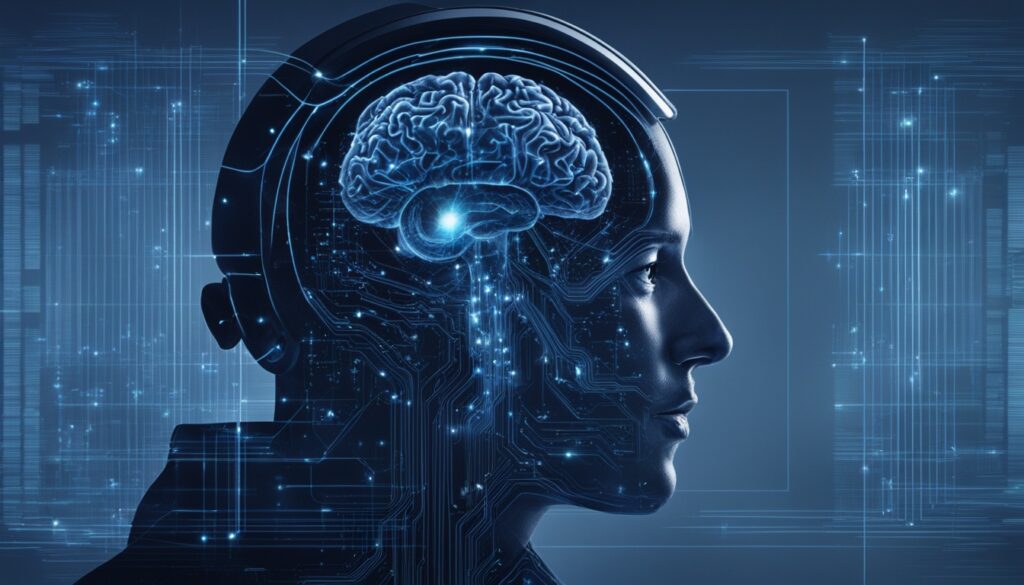For years, the idea of AI reading minds sounded like science fiction. But now, thanks to researchers at the University of Texas at Austin, it’s real. They’ve made a big leap in understanding the brain, turning thoughts into speech without surgery.
This breakthrough is a big deal for neural decoding and cognitive science. It shows how AI and brain science are coming together fast. This could change how we talk, interact, and even control gadgets in the future.
Key Takeaways
- Researchers have developed a non-invasive brain-computer interface (BCI) that can decode continuous language from the brain.
- The technique combines fMRI scans and AI language models to translate unspoken thoughts into phrases.
- This breakthrough represents a significant advancement in the fields of neural decoding, thought interpretation, and cognitive neuroscience.
- The potential for mind-reading technology to revolutionize communication and device control is vast, but it also raises serious ethical concerns.
- Ongoing research in this area aims to further refine and improve the accuracy of thought-to-speech translation using AI.
Mind-Reading Using AI: Decoding Thoughts from Brain Activity
Advances in artificial intelligence have led to big steps in neural decoding and brain-computer interfaces (BCIs). Now, researchers can read what people think by looking at their brain activity. They use functional magnetic resonance imaging (fMRI) and language models for this.
Advances in Neural Decoding and Brain-Computer Interfaces
A study in Nature Neuroscience shows a big leap forward. Researchers at the University of Texas at Austin made an AI system called a “semantic decoder.” This system turns brain activity into text while people listen to stories or imagine telling one. It’s a big step in thought recognition and cognitive state detection, and it doesn’t need surgery.
Non-Invasive Thought Interpretation Using fMRI and Language Models
Jerry Tang and Alex Huth led a study that used fMRI to watch brain activity. Participants listened to stories, and the researchers used big language models like GPT-1. They linked brain activity with words and phrases to guess what people were thinking. This shows how fMRI data analysis and brain activity interpretation can work with language models for thought recognition.
“About half of the time, the machine produces text that closely (sometimes precisely) matches the intended meanings of the original words, without being a word-for-word transcript.”
The team talked about the risks of this tech and said it worked best with willing participants. They think it could work with other brain-imaging tools, like functional near-infrared spectroscopy (fNIRS). This could make brain-computer interfaces more accessible and useful.
The Science Behind AI Mind-Reading Technology
The big leap in AI mind-reading technology comes from combining two strong tools: functional magnetic resonance imaging (fMRI) and large language models. These technologies help turn brain activity into written text with high accuracy.
Combining fMRI Data and Large Language Models
The secret to this success is using fMRI data and large language models together. fMRI scans track blood flow changes in the brain, linked to certain words or phrases. Then, a language model, like the one in ChatGPT, picks the right word order to make the text clear.
Training the Decoder on Personalized Brain Activity
The AI system, called DeWave, learns from each person’s brain patterns. This makes it work best with the person it knows. If someone tries to trick it, it won’t work well, showing how important it is to adapt to each brain.
Using combining fMRI data and large language models and training the decoder on personalized brain activity has led to a new kind of non-invasive brain imaging tech. This tech could change how people with speech problems communicate.
“The integration of fMRI data and large language models has been a game-changer in the field of mind-reading AI. By training the decoder on each individual’s unique brain activity, we’ve been able to achieve unprecedented accuracy in translating thoughts into written text.”

Potential Applications and Implications
AI mind-reading technology is making huge strides, especially for people with communication issues. It can turn brain signals into text, helping those who find it hard to speak. This could be a big help for people with certain conditions.
Restoring Speech for Patients with Communication Disorders
Companies like Elon Musk’s Neuralink and Mark Zuckerberg’s Meta are leading the way in BCIs. These could let people control devices with just their thoughts. This is a big deal for people who can’t move but want to use computers or robots with their minds.
Ethical Concerns and Privacy Issues
But, using AI mind-reading in everyday life brings up big ethical questions. It could mean others could see our deepest thoughts without us saying yes. Neuroethicists say we need strong laws before we start using this tech widely. They want to make sure it’s used right and with respect for our privacy.
AI mind-reading could also help in areas like emotional AI and brain-computer interfaces. But, we have to think about the ethics and privacy to protect our rights. We need to keep trust in this new tech.

“The integration of AI mind-reading into our daily lives raises serious ethical concerns. The ability to access people’s most intimate thoughts and memories without their consent poses a significant threat to the principle of self-determination over our own minds.”
Limitations and Challenges of Current Mind-Reading AI
[https://www.ncbi.nlm.nih.gov/pmc/articles/PMC7417394/] Mind-reading AI has made big steps forward, but it still has big hurdles. The process of decoding brain signals needs a lot of training. People spend up to 40 hours in an fMRI machine to teach the system their brain patterns. This makes it hard for many to use this technology.
The accuracy of these AI systems is about 40% now. But, new data shows they could get better than 60%. The technology has improved so much that people don’t have to say the words out loud anymore. They can just think them. Yet, the systems still have trouble with some language parts, like knowing when someone is talking about themselves or someone else.
Getting people to work with the AI is another big challenge. If a person thinks of animals or makes up a different story, the AI can get confused. Recent studies show that the AI can still work well even with data from another person. This is good news for the future.
Researchers are excited about the future of neural signal processing and machine learning for brain data. They think non-invasive brain imaging-based mind-reading AI could be very useful. But, they also know they need to think about the ethical issues. Things like privacy and how it affects our minds are very important.
Conclusion
AI-powered mind-reading technology is a big step forward in understanding the brain. It’s still not perfect and needs more work and cooperation from participants. But, it makes us think about the risks of using such tech to read our deepest thoughts without asking us first.
This tech is getting better, and we need strong laws to protect our thoughts and feelings. It could help people who can’t speak by understanding their brain signals. But, we must be careful to use this tech right and ethically.
There are big worries about our privacy and freedom when we can read each other’s thoughts. We need to protect our rights to keep our thoughts safe. This is key to making sure this tech helps us all while respecting our privacy.



